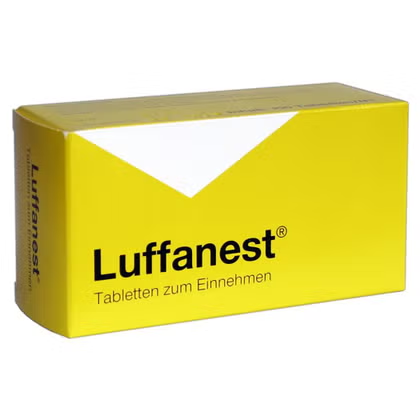What is Luffanest?
Luffanest® is an over-the-counter homeopathic medicine marketed in Germany by NESTMANN Pharma GmbH. According to the official patient leaflet, it’s intended for use in diseases of the respiratory tract, with application areas derived from homeopathic drug pictures—supportive treatment of acute and chronic inflammation of the paranasal sinuses (sinusitis) and sinobronchitis. It’s supplied as 100 scored tablets per pack (PZN 01828511) and is pharmacy-only in Germany.
Important framing: Homeopathic products are regulated differently from conventional medicines; their claimed uses are based on homeopathic principles rather than robust clinical efficacy evidence. If you have severe, persistent, or unclear symptoms—especially fever over 39 °C, shortness of breath, or purulent/bloody sputum—seek medical care promptly.
What’s in Luffanest? (Full Composition)
Per the official leaflet, each tablet contains the following homeopathic triturations (decimal potencies, “D” potencies) and excipients:
-
Luffa (Luffa operculata) Trit. D6 – 20 mg
-
Hydrastis (Hydrastis canadensis, “goldenseal”) Trit. D4 – 20 mg
-
Cinnabaris (Mercuric sulfide, HgS—“cinnabar”) Trit. D4 – 20 mg
-
Eupatorium perfoliatum (“boneset”) Trit. D5 – 10 mg
-
Cepa (Allium cepa, “onion”) Trit. D6 – 10 mg
-
Sticta (Sticta/Lobaria pulmonaria, “lungwort lichen”) Trit. D2 – 10 mg
-
Phosphorus (elemental) Trit. D6 – 10 mg
-
Natrium chloratum (sodium chloride, NaCl) Trit. D6 – 10 mg
-
Excipients: lactose, magnesium stearate, potato starch.
Multiple German pharmacy listings reproduce the same composition and indicate NESTMANN as the manufacturer.
About the potencies
The “D” scale in homeopathy denotes decimal dilutions (1:10 steps). For example, D2 is a 1:100 dilution (triturated), D4 ≈ 1:10,000, D6 ≈ 1:1,000,000, etc., typically prepared via trituration with lactose. These are not pharmacologic doses in the conventional sense.
How Luffanest is supposed to be used (per leaflet)
-
General dose (unless otherwise directed):
-
Chronic courses: 1 tablet 3× daily.
-
Acute courses: 1 tablet every hour, up to 12 tablets/day.
-
-
Pediatric guidance (from the leaflet):
-
Infants up to 1 year: only after consulting a physician.
-
Toddlers up to 6 years: no more than half the adult dose.
-
Children 6–12 years: no more than two-thirds the adult dose.
-
-
Administration tips: take before or between meals; tablets can be crushed into a soft mash for small children.
-
Duration: homeopathic remedies should not be used long-term without medical advice.
If symptoms persist/worsen or if you develop warning signs (high fever, dyspnea, purulent/bloody sputum), consult a clinician.
Safety, warnings, and side effects
-
Pregnancy & breastfeeding: insufficient documented experience; use only after medical consultation.
-
Infants: insufficient documented experience; use only after medical consultation.
-
Interactions: none known per leaflet, but general advice is to avoid aggravating lifestyle factors and stimulants during homeopathic therapy.
-
Side effects: none known per leaflet. A temporary initial aggravation of symptoms may occur; if so, discontinue and seek advice.
-
Allergy/intolerance: contains lactose. People with lactose intolerance may experience GI discomfort.
-
Storage: observe the expiry date on the pack; do not use after the labeled date.
Ingredient-by-ingredient: what each component is used for in homeopathy
The following reflects homeopathic materia medica traditions, not conventional pharmacology. Evidence for clinical efficacy of homeopathic combinations in sinusitis is limited. Use this section as an orientation to why these substances were chosen—not as proof of effectiveness.
Luffa operculata (D6, 20 mg)
Traditionally used in homeopathy for rhinitis and sinus congestion with abundant discharge or blockage. The plant is a cucurbit (“loofah gourd”). In homeopathic practice, Luffa remedies appear in combination sinus formulas. (Listed as “Luffa Trit. D6” on the leaflet.)
Hydrastis canadensis (D4, 20 mg) – Goldenseal
Associated in homeopathy with thick, stringy nasal or pharyngeal mucus, post-nasal drip, and chronic catarrh. Conventional herbal goldenseal is not the same as a homeopathic D4 trituration; the latter is highly diluted. (Listed as “Hydrastis Trit. D4”.)
Cinnabaris (D4, 20 mg) – Mercuric sulfide, HgS (“cinnabar”)
Included in homeopathic sinus remedies for frontal sinus pressure, pain at the root of the nose, and thick secretions. Note this is a homeopathic trituration at D4 (a dilution/trituration step), not a pharmacologic dose of mercury. (Listed as “Cinnabaris Trit. D4”.)
Eupatorium perfoliatum (D5, 10 mg) – Boneset
Traditionally used for flu-like malaise, bone aches, feverish colds, and upper-respiratory catarrh. (Listed as “Eupatorium perfoliatum Trit. D5”.)
Allium cepa (D6, 10 mg) – Onion
A classic homeopathic remedy for watery, burning nasal discharge and lacrimation (think “onion tears”), often considered when symptoms resemble allergic or irritant rhinitis. (Listed as “Cepa Trit. D6”.)
Sticta/Lobaria pulmonaria (D2, 10 mg) – Lungwort lichen
Used for dry nasal passages with blocked sensation and frontal sinus pressure, especially when nothing seems to discharge but the nose feels stuffed. (Listed as “Sticta Trit. D2”.)
Phosphorus (D6, 10 mg) – Elemental phosphorus
In homeopathic literature, considered in respiratory catarrh, hoarseness, and cough with sensitivity to odors or stimuli; included here likely for broader airway involvement (sinobronchitis angle). (Listed as “Phosphorus Trit. D6”.)
Natrium chloratum (D6, 10 mg) – Sodium chloride
A widely used homeopathic remedy (“Natrum muriaticum”), sometimes paired with catarrhal states, recurrent colds, and hay fever-type symptoms. (Listed as “Natrium chloratum Trit. D6”.)
Excipients: Lactose, magnesium stearate, potato starch—standard tableting agents and diluents.
Note: Some retailer pages list “Hydrargyrum sulfuratum rubrum D4” (another mercury compound) instead of “Cinnabaris D4.” The official leaflet names Cinnabaris D4, which is consistent across several pharmacy listings that quote the leaflet verbatim.
Who might consider Luffanest? (Intended use)
-
Adults and older children with acute or chronic sinus inflammation (e.g., pressure in the face, blocked nose, catarrh), or sinobronchitis, as supportive therapy based on homeopathic principles.
-
People who prefer a homeopathic approach or are seeking an adjunct to physician-guided care.
-
Those who tolerate lactose (given the tablet excipients).
Not a replacement for medical evaluation in red-flag scenarios: high fever (>39 °C), shortness of breath, purulent or bloody sputum, persistent or worsening symptoms.
How to take it effectively (practical tips)
Timing: Take before or between meals for consistency. If you’re using other homeopathic products, many practitioners suggest spacing them out, though interactions aren’t documented in the leaflet.
Acute vs. chronic dosing: For a sudden flare, short-term hourly dosing (max 12/day) may be used initially, then taper to 3× daily as symptoms ease—unless your clinician advises otherwise. For long-standing congestion, stay with 3× daily.
Kids: Observe the reduced child doses; consult a clinician for infants. Crush the tablet in a small amount of soft food for young children if needed.
Track symptoms: Note facial pain, nasal discharge character, fever, and cough. Escalate to care if no improvement after a few days or if red flags appear.
Allergies/intolerances: If you are lactose-intolerant, watch for GI symptoms; ask your pharmacist about alternatives.
Pros & cons for users
Advantages
-
OTC & pharmacy-only: easy to obtain in Germany without a prescription, but still under pharmacy oversight.
-
Targeted for sinus & sinobronchial complaints (per homeopathic drug pictures).
-
Flexible dosing for acute vs. chronic phases; child dosing guidance provided.
-
Tablets can be crushed, helpful for children or those who dislike swallowing pills.
-
No known interactions/side effects listed in the leaflet (though initial aggravation is possible).
Drawbacks
-
Evidence limitations: As with homeopathy overall, robust modern clinical efficacy data for this specific combination in sinusitis are limited.
-
Contains lactose—not ideal for those with lactose intolerance.
-
Not a substitute for medical treatment in bacterial sinusitis, pneumonia, or severe disease; doctor assessment may still be necessary.
-
Label differences online: Some retailer pages show slightly different ingredient naming (Cinnabaris vs. Hydrargyrum sulfuratum rubrum); rely on the package leaflet in your hands.
Frequently asked questions (FAQ)
Is Luffanest safe to take with my other medicines?
The leaflet lists no known interactions, but it’s good practice to ask your pharmacist—especially if you take multiple prescription drugs or have chronic conditions.
Can I take it during pregnancy or breastfeeding?
Use only after medical consultation due to insufficient documented experience.
How quickly should I expect results?
Some users of homeopathic remedies report early symptom shifts; others may not notice changes. If no improvement within a few days—or if symptoms worsen—seek medical advice.
Can children take Luffanest?
Yes, but at reduced doses as outlined above; infants under 1 year only after consulting a physician.
Does it have side effects?
None known are listed; initial aggravation is possible. Stop and consult a professional if this occurs.
How Luffanest compares to conventional sinus care
-
Conventional options for sinusitis include saline rinses/irrigations, intranasal corticosteroids, analgesics, and watchful waiting for viral cases; antibiotics are reserved for clear bacterial presentations. Luffanest is homeopathic and not a replacement for guideline-based care in moderate-to-severe disease.
-
Adjunctive role: Some patients choose Luffanest as a complementary measure alongside standard care (e.g., saline rinses, humidification, allergen control), especially in non-severe cases. If you take other meds, involve your pharmacist/clinician to keep your plan safe and coherent.
(The leaflet itself does not position Luffanest as a stand-alone cure; it provides dosing and safety guidance consistent with adjunctive, symptom-oriented use.)
Step-by-step: a sensible, user-friendly plan for sinus flare-ups
Screen for red flags (fever >39 °C, severe facial swelling, eye symptoms, dyspnea, purulent/bloody sputum). If present, seek urgent care.
Supportive basics: hydration, saline nasal rinse, rest, humidified air; consider an intranasal steroid if previously advised by your clinician for allergic components.
If choosing Luffanest:
-
-
Acute start: 1 tablet hourly (max 12/day) for the first day or two.
-
Then taper: to 1 tablet 3× daily as symptoms ease.
-
Children: use the age-adjusted fractions; infants only with medical advice.
-
Track progress for 48–72 h. If no improvement or if you worsen, contact your clinician.
Avoid irritants (smoke, strong fumes). The leaflet notes that lifestyle and stimulants can unfavorably influence homeopathic treatment.
Practical buying & packaging notes
-
Pack size: 100 tablets; not dose-equally divisible per some database listings (be cautious splitting).
-
Pharmacy-only (Germany): You got that without any perception but availed on pharmacies.
-
Manufacturer: NESTMANN Pharma GmbH, Weiherweg 17, 96199 Zapfendorf/Bamberg, Germany.
Bottom line
Luffanest® is a homeopathic combination aimed at sinus and Sino bronchial complaints. Its formula blends plant, mineral, and elemental trituration’s (D2–D6) that homeopathic tradition associates with nasal blockage, catarrh, facial pressure, and cough-catarrh overlap. The official leaflet provides clear dosing for acute vs. chronic phases and age-adjusted guidance, with no known interactions and no known side effects reported—though initial aggravation and lactose intolerance should be considered.
For users who prefer a homeopathic adjunct, Luffanest can fit into a broader self-care plan (saline rinses, rest, trigger reduction). However, given the evidence limitations for homeopathic efficacy, it shouldn’t delay appropriate medical evaluation—especially in severe, persistent, or atypical cases. When in doubt, talk to your pharmacist or physician.
Sources & further reading
-
Official patient leaflet (Gebrauchsinformation), Luffanest® (Nestmann): composition, dosing, warnings, side effects, storage. (Stand: July 2002; hosted by retailers/health portals)
-
Apotheken Umschau (ABDATA): product entry, pack details, link to original leaflet; updated 26.09.2024.
-
German pharmacy listings replicating the official composition and indications: Wir leben Apotheken; Paul Pille; DocMorris; Shop-Apotheke.
If you want, I can turn this into a printable one-pager (patient handout) or a side-by-side comparison with non-homeopathic sinus options (saline irrigation, intranasal steroids, decongestants) so users can choose what fits them best.

